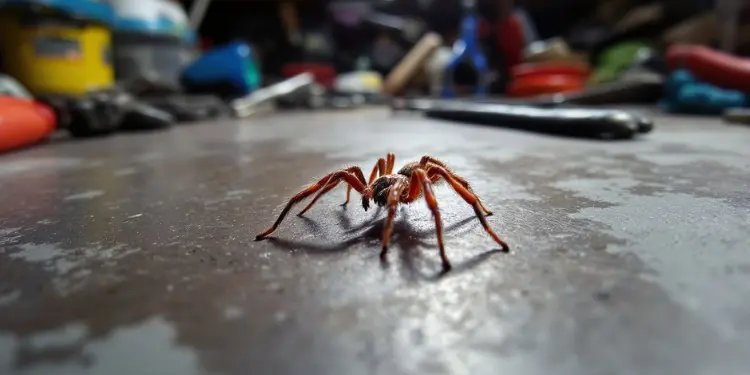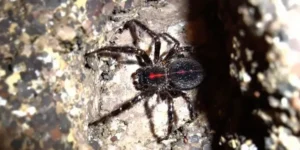Redback spider bites can be frightening. These spiders inhabit various regions across Australia. This guide will inform you about redback spider treatment. Continue reading to learn safety measures for Redback Spider Treatment.
Key Takeaways
- Redback spider bites cause pain, swelling, and nausea. Apply a cold pack for 20 minutes to ease pain.
- Don’t use a pressure bandage for redback bites. It won’t help. Seek medical help for kids, older adults, or if symptoms get worse.
- No deaths from spider bites in Australia since antivenom was made. Call 000 if someone faints or has bad pain.
- Wear gloves and long pants when outside to avoid bites. Check shoes before wearing them.
- Redback spiders are black with a red stripe. They’re more risky for kids than white-tailed spiders, but less deadly than funnel-web spiders.

Signs and Symptoms of Redback Spider Bites

After learning about redback spiders, it’s crucial to recognise their bite symptoms. Redback spider bites cause immediate pain at the bite site. The area becomes red, hot, and swollen.
Pain intensifies and spreads over time.
Additional symptoms develop as the venom takes effect. Nausea and vomiting may occur. Abdominal pain is also possible. The bite area produces excessive sweat. Lymph nodes near the bite become swollen.
As time progresses, the pain becomes severe. Patchy sweating, headaches, and weakness may develop. Some individuals experience muscle spasms. These symptoms indicate the need for urgent medical attention.
Immediate First Aid Steps for Redback Spider Bites
Now that we understand the signs of a redback spider bite, we’ll focus on immediate actions. Prompt response can significantly impact recovery outcomes from a bite.
- Lay the person down and keep them calm. This helps slow the spread of venom.
- Monitor the person closely. Observe any changes in their condition or behaviour.
- Apply a cold pack to the bite area. Hold it there for up to 20 minutes to ease pain.
- Clean the bite spot thoroughly. Use soap and water to wash it.
- Record the time of the bite. Also note when you applied the cold pack.
- Seek medical help if necessary. This is crucial for children, older adults, or if someone’s condition worsens.
- Avoid attempting to catch the spider. Prioritise caring for the person who was bitten.
- Immobilise the bitten body part. This can help slow the venom’s spread.
- Remove any tight clothes or jewellery near the bite. Swelling might constrict these items.
- Avoid using a pressure bandage. It’s ineffective for a redback spider bite.
Applying a Cold Compress
Applying a cold compress is a crucial step in treating redback spider bites. It helps ease pain and swelling from the bite.
- Use a cold pack or ice wrapped in a cloth on the bite area
- Keep the cold compress on for up to 20 minutes at a time
- Don’t put ice directly on your skin to avoid frostbite
- Repeat using the cold pack every 2 hours as needed
- A damp, cool towel works if you don’t have an ice pack
- Cold helps manage the severe pain that spreads from the bite
- Make sure to use a cloth or towel between the cold and your skin
- The cold reduces swelling around the bite site
- You can use frozen veggies in a bag as a cold pack too
- Stop using the cold pack if your skin feels numb
Seeking Medical Attention
Seek medical attention promptly if a young child, older person, or sick person is bitten. Contact emergency services on triple zero (000) immediately if someone loses consciousness or experiences severe pain.
It’s reassuring that no fatalities have occurred from spider bites in Australia since the development of antivenom. If possible, capture the spider safely. This assists medical professionals in identifying the species and determining appropriate treatment.
They may need to administer specific antivenom.
Be alert for symptoms indicating a severe reaction. These can include profuse sweating, muscle weakness, or muscle spasms. If these occur, seek immediate medical assistance. The Australian Venom Research Unit (1300 760 451) or Victorian Poisons Information Centre (13 11 26) can provide guidance as well.
Now, we’ll examine the treatment protocols for redback spider bites.
Management of Redback Spider Bites
After obtaining medical assistance, appropriate care is essential. Handling redback spider bites requires a composed approach. First, clean the bite area with soap and water. This aids in cleansing the wound and may lower infection risk.
Subsequently, use a cold pack to alleviate pain. Rest is crucial for recovery. Keep the patient stationary and relaxed. Monitor them closely for any new symptoms. Record the time of the bite and the spider’s appearance.
This information can assist doctors in treating the bite more effectively. If symptoms worsen, return to the doctor promptly. With proper care, most individuals recover well from redback spider bites.
Supplementary Tips for Redback Spider Bites
We have additional advice to help protect you from redback spiders. Continue reading to discover more about preventing bites and maintaining your safety.
Preventing Spider Bites: Redback Spider Treatment
Keeping spiders away is essential to avoiding bites. Here are some tips to help you stay safe:
- Wear gloves when gardening. This protects your hands from hidden spiders.
- Put on long trousers and shoes outside. Covering up reduces the risk of spider bites.
- Check shoes before wearing them. Spiders often hide in dark spots.
- Teach children not to touch spiders. This helps them avoid bites.
- Use flyscreens on windows. They prevent spiders from entering your home.
- Add draught-strips to doors. This blocks small gaps spiders can crawl through.
- Clean areas where spiders might hide. Regular tidying reduces potential spider habitats.
- Contact pest control if needed. Professionals can assist with significant spider issues.
- Shake out clothes before wearing. This removes any hiding spiders.
- Be aware of spider webs. Where there’s a web, a spider is likely nearby.
- Keep your yard tidy. Trim bushes and clear clutter to reduce spider habitats.
- Use natural spider deterrents. Peppermint oil or vinegar can discourage spiders.
Now, we’ll examine how to identify common venomous spiders in Australia.
Identifying Common Venomous Spiders
Identifying dangerous spiders in Australia is essential for safety. Four main types present risks: funnel-web, mouse, redback, and white-tailed spiders. Female redbacks measure about 10 mm in length, with a red stripe on their back.
Funnel-webs are dark and glossy, with male Sydney funnel-webs being the most lethal. Mouse spiders resemble funnel-webs but have shorter legs. White-tailed spiders are slim with a white tip on their rear.
Not all spiders in Australia are harmful. Black house spiders, huntsman spiders, trapdoor spiders, and wolf spiders are common but safe. These spiders may appear frightening, but they won’t cause harm.
Recognising different spider species can help maintain calmness and safety. We’ll now examine when to apply a pressure bandage for spider bites.
When to Use a Pressure Bandage: Redback Spider Treatment
Moving from identifying dangerous spiders, we’ll discuss treating their bites. Pressure bandages are essential in first aid for funnel-web and mouse spider bites. These spiders require specific treatment.
Use an elastic roller bandage that’s 10-15 cm wide. Begin wrapping from the fingers or toes and progress up the limb. Apply sufficient pressure to restrict finger movement. This technique reduces the venom’s spread in the body.
Following bandaging, immobilise the limb. Apply a splint to prevent movement. The affected person should lie down and remain calm. Record the time of the bite and when the bandage was applied.
This information assists doctors in providing appropriate treatment. Always seek immediate medical attention after applying a pressure bandage.
Comparison Table: Redback Spider vs. Other Venomous Spiders
Redback spiders are not the only venomous spiders in Australia. A comparison with other common venomous spiders highlights their unique traits and risks.
| Feature | Redback Spider | Sydney Funnel-web Spider | White-tailed Spider |
|---|---|---|---|
| Appearance | Black with red stripe on back | Dark, shiny, and large | Grey with white-tipped abdomen |
| Venom Toxicity | High | Very high | Low |
| Bite Symptoms | Pain, sweating, nausea | Severe pain, vomiting, trouble breathing | Mild pain, itching |
| Risk to Humans | Serious for children | Life-threatening | Generally mild |
| First Aid | Cold pack, seek medical help | Pressure bandage, urgent medical care | Clean wound, cold pack |
Redback spiders pose a serious risk to children. Their bites cause pain, sweating, and nausea. Sydney funnel-web spiders are more dangerous, with bites that can be life-threatening. White-tailed spider bites are usually mild. Each spider needs different first aid. For redbacks, use a cold pack and get medical help. It’s important to be careful around spiders and educate children about spider safety.
Conclusion
Understanding how to manage redback spider bites is crucial for safety. Prompt action and correct first aid are essential. Always obtain medical assistance for severe cases. Remain composed and follow the recommended steps.
With proper knowledge, you can protect yourself and others from these Australian arachnids.
For more in-depth information on managing redback spider bites, visit our comprehensive guide here.
FAQs
1. What Redback Spider Treatment should I do if a redback spider bites me?
Stay calm… it’s key. First, clean the bite area with soap and water. Then, apply a cold pack to ease pain and swelling. Don’t use a bandage or tourniquet – it won’t help. Get to a hospital quick, as you might need antivenom.
2. How can I tell if it’s a redback spider bite?
Look for a red mark that stings and burns. You might feel sick, sweat a lot, or have tummy pain. These signs often show up fast after the bite. If you spot a spider with a red stripe, it’s likely a redback.
3. Is a redback spider bite always serious?
Not always, but it can be. Some bites cause mild symptoms, while others can make you very ill. Kids and older folks are at higher risk. It’s best to see a doctor for any redback bite, just to be safe.
4. Can I do Redback Spider Treatment at home?
For first aid, yes – but proper treatment needs a doctor. At home, keep the bite area clean and cool. Take pain relief if needed. But don’t delay – get medical help soon. Only a doctor can decide if you need the special antivenom.





